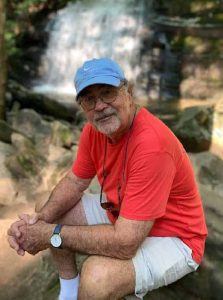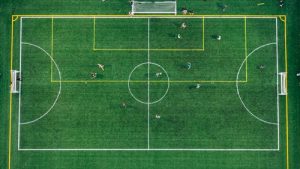Number eight seed SMU will face number one seed Virginia and number seven seed Stanford will tangle with Clemson on Friday. UC Santa Barbara will face number four seed Wake Forest and number six seed Washington will square off with number three seed Georgetown on Saturday. The four winners will advance to the College Cup the following weekend in Cary, North Carolina.
 Virginia (19-1-1) – Junior midfielder Joe Bell, sophomore forward Daryl Dike and junior goalkeeper Colin Shutler are among the names that are often mentioned, and deservedly so, when discussing the success that Virginia has had this year.
Virginia (19-1-1) – Junior midfielder Joe Bell, sophomore forward Daryl Dike and junior goalkeeper Colin Shutler are among the names that are often mentioned, and deservedly so, when discussing the success that Virginia has had this year.
But don’t overlook the steady play and the contribution that junior midfielder Irakoza Donasiyano has had on the Cavaliers from the get-go. It is also noteworthy that freshman forward Axel Gunnarsson (1g, 4a) has added depth to the attack while junior defender Spencer Patton (4g, 1a) and sophomore midfielder Bret Halsey (1g, 2a) are among returning players who have upped the level of their play and their contribution significantly this year.
Defense is a collective effort at Virginia but a team doesn’t record fifteen shutouts as the Cavaliers have this year without an athletic and composed duo at center back. Junior Henry Kessler and freshman Andres Ueland combine to give Virginia a center back combination that is among the best, if not the best, in the country.
 SMU (18-1-1) – The Mustangs entered the 2019 season with a deep roster and a strong desire to make a deeper run in the NCAA Tournament than the 2017 and 2018 teams. The 2017 team that was 17-3-1 was eliminated in the third round and the 2018 team that was 10-5-3 was eliminated in the first round by Oregon State.
SMU (18-1-1) – The Mustangs entered the 2019 season with a deep roster and a strong desire to make a deeper run in the NCAA Tournament than the 2017 and 2018 teams. The 2017 team that was 17-3-1 was eliminated in the third round and the 2018 team that was 10-5-3 was eliminated in the first round by Oregon State.
Senior forward Garrett McLaughlin (16g, 5a), senior back Eddie Munjoma (11g, 8a), sophomore midfielder Knut Alexander (7g, 12a) who has had a breakout season, and junior goalkeeper Grant Makela (0.82 gaa) are among a solid group of returning players who have played a key role in the Mustang’s 18-1-1 season to date and run to the Elite Eight.
Newcomers have also made a key contribution. Kevin Hudson did a good job of strengthening his team adding a recruiting class that included four transfers who hit the ground running. Sophomore Gabriel Costa (7g, 10a) who transferred in from Azusa Pacific University, junior defender Henrik Bredeli (2g, 3a) who transferred from North Carolina, junior defender Brandon Terwege (2g, 3a) who transferred from UCLA and sophomore forward Nick Taylor (0g, 3a) who transferred from New Mexico are among the reasons why this team has been so successful.
SMU’s lone loss of the 2019 season was a 4-3 setback at home against Memphis. In that contest Memphis effectively counter attacked and converted two headers out of corner kicks including the game-winner in overtime to top SMU. The Mustangs will have to contain counter attacks and tighten up their defense out of set pieces in order to advance past Virginia in the Elite Eight.
 UC Santa Barbara (15-4-4) – The Gauchos are playing with house money and enjoying it as the lone non-seeded team in the Elite Eight. UC Santa Barbara’s 2-0 loss to UC Davis in the championship match of the Big West Tournament in which the intensity of their play didn’t match the Aggies appears to have served as a very timely wakeup call. Since that game the Gauchos have upped the intensity of their play securing a 3-1 win over California, a 4-0 win over twelve seed St. Mary’s 4-0, and a 1-0 win in Bloomington over five seed Indiana 1-0 in overtime. The Gauchos are playing their best soccer of the year.
UC Santa Barbara (15-4-4) – The Gauchos are playing with house money and enjoying it as the lone non-seeded team in the Elite Eight. UC Santa Barbara’s 2-0 loss to UC Davis in the championship match of the Big West Tournament in which the intensity of their play didn’t match the Aggies appears to have served as a very timely wakeup call. Since that game the Gauchos have upped the intensity of their play securing a 3-1 win over California, a 4-0 win over twelve seed St. Mary’s 4-0, and a 1-0 win in Bloomington over five seed Indiana 1-0 in overtime. The Gauchos are playing their best soccer of the year.
Credit UCSB head coach Tim Vom Steeg for making adjustments that have put his team in the best possible posture to win. The Gauchos will play Wake Forest in the Elite Eight without the services of senior defensive midfielder Sahid Conteh who was injured in the win over California and junior center back Hunter Ashworth who was awarded his eighth yellow card of the season in the win over Indiana. The potential exists for that to take a toll on UCSB’s ability to halt a very dangerous Wake Forest attack. Defensive midfielders Mateo Restrepo Mejia and freshman Sam Fletcher and backs Noah Billingsley, William Gillingham, and Faouzi Taied are among those who will be tasked with containing a Wake Forest midfield that is among the best in the country.
 Wake Forest (15-4-2) – The Demon Deacons are playing with a renewed sense of energy and focus which is exactly what is needed to survive and advance this time of the year. Wake Forest has been a bit tough to get a handle on this year in part because they have had injuries that have impacted the consistency of their play. The Demon Deacons are at their best when knocking the ball around, maintaining possession, moving off the ball and finding a weakness they can exploit. This is a team that truly enjoys the game when they are clicking.
Wake Forest (15-4-2) – The Demon Deacons are playing with a renewed sense of energy and focus which is exactly what is needed to survive and advance this time of the year. Wake Forest has been a bit tough to get a handle on this year in part because they have had injuries that have impacted the consistency of their play. The Demon Deacons are at their best when knocking the ball around, maintaining possession, moving off the ball and finding a weakness they can exploit. This is a team that truly enjoys the game when they are clicking.
If they get into a rhythm and are able to control the middle third, they are almost unstoppable. Bruno Lapa (9g, 3a) is a prime timer who is capable of taking over a contest. Kyle Holcomb (9g, 0a) has emerged as a key threat up-top while Machop Chol (4g, 8a), Calvin Harris (6g, 3a) and Isaiah Parente (1g, 7a) add balance to the attack. Regardless, its guys like backs senior Alistair Johnson (2g, 5a) and junior Michael DeShields who are the heart and soul of this team.
 Georgetown (17-1-3) – The Hoyas advanced to the national championship contest in 2012 and to the Elite Eight in 2014 but for the most part they have underachieved in NCAA Tournament play. In 2015 the number three seeded Hoyas fell in the Sweet Sixteen. In 2017 the number fourteen seeded Hoyas lost in the second round to SMU in overtime. In 2018 the thirteenth seeded Hoyas were upset by Michigan State in the third round.
Georgetown (17-1-3) – The Hoyas advanced to the national championship contest in 2012 and to the Elite Eight in 2014 but for the most part they have underachieved in NCAA Tournament play. In 2015 the number three seeded Hoyas fell in the Sweet Sixteen. In 2017 the number fourteen seeded Hoyas lost in the second round to SMU in overtime. In 2018 the thirteenth seeded Hoyas were upset by Michigan State in the third round.
The number three seeded 2019 squad may be different due to four factors. First, the Hoyas are playing their best soccer of the year on both sides of the ball as reflected in their 5-0 win over Pitt and 5-1 win over a Louisville team that they lost to 1-0 in regular season play. Second, this is a very deep team with a lot of guys like sophomore forward Zach Riviere and midfielders Paul Rothrock, Jack Beer and Dante Polvara among others who are capable of making big plays. Third, this team does a very good job of creating and finishing scoring opportunities. Fourth, they have been very effective at matching the physicality of their opponents while continuing to play with the patience and composure they need to settle into a rhythm.
 Washington (17-3-0) – The Huskies have recorded seventeen wins this year for the first time since 1983 and have advanced to the Elite Eight for the second time in the history of the program with the first coming back in 2013. Washington has had trouble in the past finding a balance between big play ability on the offensive side of the ball and solid play on the defensive side of the ball but not this year.
Washington (17-3-0) – The Huskies have recorded seventeen wins this year for the first time since 1983 and have advanced to the Elite Eight for the second time in the history of the program with the first coming back in 2013. Washington has had trouble in the past finding a balance between big play ability on the offensive side of the ball and solid play on the defensive side of the ball but not this year.
Their attack led by midfielders Blake Bodily (12g, 6a) Lucas Meek (6g, 7a), Jaret Townsend (6g, 1a) and Dylan Teves (1g, 8a) has produced a total of forty-four goals while a solid defense anchored by backs Ethan Bartlow, Kasey French, Freddy Kleeman and Charlie Ostrem and most recently by freshman goalkeeper Sam Fowler but also at times by redshirt junior Bryce Logan has allowed a total of only twelve.
Washington matches up well with Georgetown so their Elite Eight match with the Hoyas is going to come down to which team is able to get into a rhythm on the offensive side of the ball. Neither team wants to have to fall behind and chase the game.
 Stanford (14-2-4) – The Cardinal have advanced to the Elite Eight five years in a row. During that time several of their key wins along the way have been on the road so the fact that they are traveling to face number two seed Clemson is not as big a hurdle as one might think.
Stanford (14-2-4) – The Cardinal have advanced to the Elite Eight five years in a row. During that time several of their key wins along the way have been on the road so the fact that they are traveling to face number two seed Clemson is not as big a hurdle as one might think.
Ironically, Stanford’s lone loss in the Elite Eight over the past four years was a contest at home last year in which they were defeated by Akron 3-2. In that contest Stanford uncharacteristically allowed Akron to jump out to a 2-0 lead at halftime. Although Stanford’s play on the defensive side of the ball is their calling card, the Cardinal struggle when they don’t take the game to their opponent.
Stanford can’t allow Clemson to settle into a rhythm and they can’t afford to take their foot off the gas if they hope to leave Historic Riggs Field with a win.
 Clemson – Clemson’s two losses this year were to number four seed Wake Forest 3-2 in overtime and number one seed Virginia 3-1 in the championship match of the ACC Tournament. In both of those games Clemson had a 1-0 advantage at halftime but were unable to hold onto it.
Clemson – Clemson’s two losses this year were to number four seed Wake Forest 3-2 in overtime and number one seed Virginia 3-1 in the championship match of the ACC Tournament. In both of those games Clemson had a 1-0 advantage at halftime but were unable to hold onto it.
This is a very good Clemson team but in order to advance past Stanford in the Elite Eight they will have to put together two complete halves of play including the first and last five minutes of each half. Stanford is as good as any team in the country in prevailing in close contests and will have an edge if the contest should require a penalty kick shootout to determine who advances.
Number two seeded Clemson will need to play with a sense of urgency while maintaining the composure and confidence that helped them advance past Charlotte and Providence in overtime to reach the Elite Eight.






